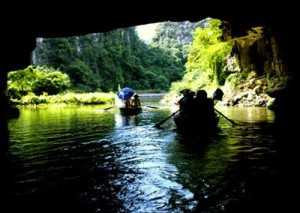Located in the centre of the province of Ninh Binh province, 80 km from the city of Hanoi to the south, Trang An is a complex of scenic landscapes and historical and cultural heritages boasting a system of adjoining limestone mountains and valleys belonging to the ancient ocean branch of the Tethys from China into Vietnam, on an area of around 10,000 ha, including three areas: Trang An eco-tourism site, Tam Coc – Bich Dong tourism site and Hoa Lu Ancient Capital cultural and historical heritage site. See more Vietnam World Heritages.
Trang An complex is often referred to as a “Ha Long Bay on land”, but few people know that only a few thousand years also there existed an ancient bay demonstrated by the water marks on the limestone cliffs, vestiges of oysters on them, abrasion terraces, and marine sediments of the Quaternary period.
Trang An is also a tropical karst landscape with a humid monsoon climate, and witnessed a lot of sea invasions and transformations similar to Ha Long Bay; its karst landscape are terrestrial, concentrated on a smaller area, and regular in variety of shapes and sizes.
The landscape is replete with tower shaped karst along the fringe of a block of limestone islands with flat peaks of varying styles. The karst islands are widely scattered among incoherent flat fields and, in season, neighbor to a sea of golden grain.
 These cone shapes of different sizes seem to be floating, scattered and unconnected on the even and flat rice fields, filed with the color of ripen rice. The karst landscape, with a pyramid shape in the middle, connects the sharp pointed peaks into a chain with vertical cliffs enclosing deep valleys in an isometric or linear form.
These cone shapes of different sizes seem to be floating, scattered and unconnected on the even and flat rice fields, filed with the color of ripen rice. The karst landscape, with a pyramid shape in the middle, connects the sharp pointed peaks into a chain with vertical cliffs enclosing deep valleys in an isometric or linear form.
Trang An is made up of a complex of scenic landscapes and has intricate and diversified ecosystems, particularly as a cradle of the prehistoric people.
All these factors have made a scenic landscapes complex of Trang An to have outstanding and distinctive values terms of landscape, geomorphology, geology, and culture.
Values in terms of landscape and karst geomorphology:
Trang An has many types of distinctive and unique karst landscape: “remaining karst hills separated from the plains”, “peaks connecting valleys”, “peaks connecting sinkholes”, “tropical karst submerged by the sea”.
No where else in the world is there a landscape similar to Ha Long Bay but fossilized on land like in Trang An.
No where else in the world is the karst terrain shaped like a narrow wall with sloped skeleton walls extending into an arch enclosing a large, empty space inside like that in Trang An – the rock capital city.
Geological and geomorphologic values:

Trang An, Ninh Binh province is located in an area full of historical geological upheavals: bearing unique characteristics in terms of structure and tectonics in the style of a “broken rice pancake”.
Trang An is characterized by a “meshy” network of young isometric non-pronous sinkholes.
The long and wide valley connected with the aged plains in the Southeast parts of the Trang An limestone block is characteristic: They become narrower toward the northwest and extends toward the southeast.
The typical “pulse” neotectonic movements lead to the formation of a “surface balance valley” and “front mountain balance surface.” The three floors of the cave area 10m – 20m, 20m – 30m and 40m – 60m.
Cultural values:
Recently scientists from the Cambridge University (the UK) and the Vietnam Archaeology Institute conducted surveys, research and eight archaeological excavations at Nui Tuong Cave, Oc Cave, vang stone roof, Ong Hay stone roof, Cho stone roof, Trong Cave, Boi Cave and five relics at Hang Pagoda.
The results included many working tools, pottery, and food remains of the ancient people such as animal bones, shells of species of mollusks and crustaceans.
Especially, excavations found human remains in three of six locations. Based on the results of the research, scientists at home and abroad have put forward some initial assessment of the value of the prehistoric culture of the Trang An region.
Trang An pre-historic relics are concentrated in high density, forming different groups in the swampy and follow karst valley. Scientists discovered a relatively intact cultural layer from 1.0m – 2.0m thick, reflecting one or two periods, before, during or after the middle Holocene marine transgression.
The tradition of manipulating limestone objects and using of chiseling tools made from limestone was long maintained.
Pottery appeared early, and was homogeneous in material, pattern, and type among the relics and stayed stable and unified during the long history of the culture of the swampy and hollow valley.
Permanent settlements took place in the caves (2,300 – 3,000 years ago), affected by changing karst valley landscape environment, caused by marine transgression and recession.
Assorted livelihoods were evident along a wide spectrum, with gathering overrunning hunting, planting outdoing animal husbandry, and adaptations to the natural environment.
Trang An landscapes complex boasts outstanding, fascinating and unique values in terms of natural landscapes and preserves the vestiges of natural history, cultural imprints, and many remains of outstanding traditional cultural values of the local communities that are being promoted and conserved.
Find Trang An landscapes with Google Map:
[gmap width=”650″ height=”300″ address=”Trang An landscapes, ninh binh”]
Source: CPV
